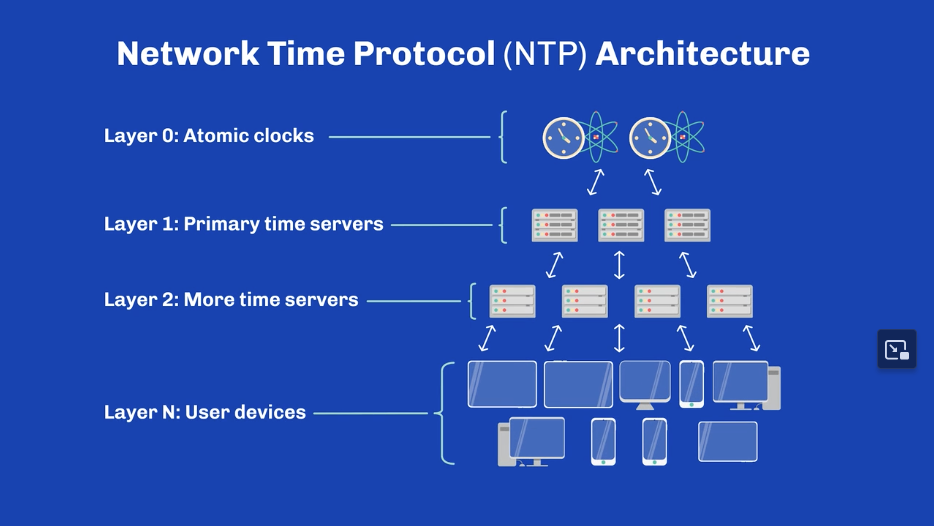Network Time Protocol (NTP) is a protocol used to synchronize the clocks of computers and devices across a network. It ensures that the system clocks of multiple machines, regardless of geographic location, remain in sync with each other. This is critical for many applications, such as logging events, coordinating processes, or ensuring security mechanisms function correctly.

Key Features of NTP
- Time Synchronization:
- NTP synchronizes the clocks of devices to within milliseconds of the correct time, allowing systems on a network to maintain accurate timestamps for events.
- It typically synchronizes to Coordinated Universal Time (UTC), using a hierarchy of time sources.
- Hierarchy of Servers (Stratum Levels):
- NTP Servers are organized in a hierarchical structure known as stratum levels:
- Stratum 0: Devices like atomic clocks or GPS receivers that provide the most accurate time source.
- Stratum 1: Computers connected directly to Stratum 0 devices, acting as primary NTP servers.
- Stratum 2 and below: Servers connected to Stratum 1 servers, providing time to other clients and acting as lower-level time servers.
- Each level is one “hop” away from a more accurate source, meaning Stratum 2 gets its time from Stratum 1, Stratum 3 from Stratum 2, and so on.
- NTP Servers are organized in a hierarchical structure known as stratum levels:
- Accuracy:
- NTP can achieve millisecond-level accuracy over the internet and even better accuracy on local networks.
- It uses algorithms to account for network delays and adjust the time accordingly, improving precision.
- Polling and Adjustment:
- NTP works by having a client regularly poll an NTP server to get the current time. The protocol calculates network delays and adjusts the time on the client machine accordingly.
- Over time, NTP makes gradual adjustments to the system clock to avoid abrupt changes that might disrupt processes.
- Security:
- NTP includes mechanisms to authenticate time sources, preventing malicious entities from tampering with time synchronization (known as NTP spoofing). For example, NTPv4 supports symmetric key encryption for server authentication.
How NTP Works
- A client (like a computer or a router) sends a request to an NTP server to get the current time.
- The server responds with a timestamp, and the client calculates the time difference between its own clock and the server’s clock.
- The client adjusts its own clock to match the server’s time, taking into account the network delay.
- Over time, the client continues to poll the server to maintain synchronization, making small adjustments as needed to stay accurate.
Use Cases of NTP
- Distributed Systems: In large-scale systems or networks with multiple computers (like a data center or blockchain network), keeping all machines synchronized is crucial for coordinating processes and ensuring consistent logging.
- Logging and Auditing: Accurate timestamps are essential for event logging in systems like financial transactions, network events, or security audits. NTP ensures that all devices have the same time, which helps in analyzing logs accurately.
- Security Protocols: Time synchronization is important for security mechanisms like Kerberos or TLS certificates, where timestamps are used to verify the validity of requests or certificates. Incorrect time can result in authentication failures or security vulnerabilities.
- Telecommunications: In telecom networks, accurate timing is essential for call management, data packet synchronization, and ensuring that data is transmitted and received at the right intervals.
NTP vs SNTP
- NTP (Network Time Protocol): Provides precise time synchronization with complex algorithms to adjust for network delays and ensure high accuracy. It’s ideal for systems where precise time is critical.
- SNTP (Simple Network Time Protocol): A simpler version of NTP, offering basic time synchronization but without the advanced features for adjusting delays and improving accuracy. SNTP is used in less critical systems where millisecond-level accuracy is not required.
Real-World Example
Imagine a bank’s system that handles millions of transactions per day. If the clocks on the bank’s servers are not synchronized, the bank could record transactions out of order, creating errors or confusion. NTP ensures that all servers have the exact same time, so transactions are accurately timestamped in the order they occur, maintaining consistency across the system.
ELI5 (Explain Like I’m 5)
Think of NTP as a school where everyone needs to make sure their clocks show the same time so that all the students go to lunch, recess, and class at the right time. There’s a super-accurate clock (like a principal’s clock), and all the classrooms check in with that clock regularly to adjust their own clocks. That way, no one is late, and everyone stays in sync!
Conclusion
Network Time Protocol (NTP) is an essential technology for ensuring that systems on a network maintain consistent and accurate time. It is widely used across industries for keeping devices in sync, securing transactions, ensuring accurate logging, and supporting time-sensitive applications.

Leave a Reply